ISSN ONLINE(2319-8753)PRINT(2347-6710)
ISSN ONLINE(2319-8753)PRINT(2347-6710)
Klotilda Marku1, Renata Kongoli2 and Vlash Mara2
|
| Related article at Pubmed, Scholar Google |
Visit for more related articles at International Journal of Innovative Research in Science, Engineering and Technology
The study aims to assess the physico-chemical characteristics and the identification of aromatic compounds in the alcoholic distillate produced by the variety Pearl of Csaba that is cultivated in Perlat- Durres Albania. In this study is monitorate the variability of these compounds after 1 and 2 years of ageing in Q.robur and 1 and 2 years preserved hermetically closed in glass container. The distillate produced from this variety is cultivated in ecosystem that have been studied before, presents good organoleptic characteristics expressed fine flower aroma characteristic of the variety. Evaluation of physico-chemical characteristics is carried out according to the OIV methods, identification of aromatic compounds expressed in esters, aldehydes and terpenole is performed by GC-FID and GC- MS according to the European normative regulation REG-CE 2870/2000. From the analytical results that are obtained respectively from the fresh distillate, the aged distillate and the stored one we see that some compounds increase in level such asË The amount of total higher, acetaldehyde concentration increased in lower levels during aging time it owes to the distillation system and the wood species Q. robur. Terpenoles such as linallol, geraniol, citronellol have a huge increasement after 2 years of ageing time in Querciusrobur oak. So linallol goes from 7.6 gr/hl a.ato 13 gr/hl after 2 years of ageing time. Geraniol goes from 4.5 gr/hl a.ato 9.6 gr/hl after 2 years of ageing time. Citronellol goes from 5.6 gr/hl a.ato 9.5 gr/hl after 2 years of ageing time. Geraniol goes from 4.5 gr/hl a.ato 7.9 gr/hl after 2 years of storing time. But the other analisedterpenoles does not change in significant means. These components are the main responsive for the flower aroma of the distillate. The organoleptic evaluation shows that the distillate produced from Pearl of Csaba shows fragrance of flowers which refers to the grape variety, the change of the aromatic compounds and the chemical characteristics is notable during the aging process, while during glass storeing we don’t see very big changes.
Keywords |
| Pearl von csaba; fragrance component; monoterpenoles; Perlat; higher alcohols; geraniol. |
INTRODUCTION |
| Pearl or as known in the world with the nomination Perla von csaba is a white grape variety with very early maturity originating from Hungary, but for a long time it is cultivated in Albania. Is produced by grafting the variety Madeleine Angevine x Muscat Courtillierand is highly susceptible to frost (Adolf Stark and Janos Mathiasz)Although the cultivation of this variety is problematic because of the thin-skinned grains of the grape. Cultivation of this variety in our country requires specific climatic and soil conditions, in accordance with the requirements of this plant for its growth and development selected ecosystem best meets these conditions. Best organoleptic characteristics make this variety to be very congenial in the production of a characteristic Albanian drink such as Raki, to which through the process of fractioned distillation of fermented grape must pass the aromatic compounds derived from grapes and those of taste the odor formed during the fermentation process. Raki was first produced from the residue of grapes left over from wine making. For good quality raki, is prefered the seedless raisins without reins (K. MARKU and R.KONGOLI) [1].There are four broad groups under which most of the flavor compounds from the grape and fermentation can be classified: aldehydes, higher alcohols, esters and volatile acids. Monoterpenes (linalool and alpha terpineol) and ketones may be generated through break down and rearrangement of various terpenoid components (de Bod et al., 2008) [2]. The characteristic fruit flavors of wine are primarily due to a mixture of hexyl acetate, ethyl caproate, ethyl caprylate, isoamyl acetate and 2-phenylethyl acetate, that have specific functions in the yeast cell, while others are still speculative (Pretorius and Lambrechts, 2000) [3]. Higher alcohols are produced during alcoholic fermentation through the conversion of the branched chain amino acids present in the medium (valine, leucine, isoleucine, threonine and phenylalanine), and are important precursors for the formation of esters, which are associated with pleasant aromas. (Clemente-Jiminez et al., 2005) [4]. The temperature of fermentation has a considerable effect on the aromatic character of the wine. Low temperatures and slower fermentations are well known to help retain the fruit character of the juice. These aromatic compounds are lost at high temperatures. The influence of fermentation temperature on the production of yeast-derived aroma compounds at 15Ãâ¹ÃÅ¡C and 28Ãâ¹ÃÅ¡C was investigated. Higher concentrations of compounds related to fresh and fruity aromas were found at 15Ãâ¹ÃÅ¡C, while higher concentrations of flowery related aroma compounds were found at 28Ãâ¹ÃÅ¡C. The formation rates of volatile aroma compounds varied according to growth stage. The distillate is more likely to contain high levels of fatty acids and their esters (e.g. ethyl caprylate, ethyl caprate, ethyl laurate) that enhance fruity aromas in distillate. According to L´eaut´e (1990), fatty acids give the brandy body and are like ‘fixatives’ for many other aromatic components. During barrel maturation, the distillate changes in flavor and color from colorless fresh distillate to the golden brown aged version. |
MATERIAL AND METHODS |
| The study was conducted on the alcoholic distillate produced by grape variety Pearl cultivated in Durres- Albania during 2010. This area is characterized as part of the Mediterranean climate zone, where the sum of actionable temperatures during the year is 3705°C, with 385mm rainfall ocure during vegetation. The average annual temperature in the area is 11.5°C, while the average temperature during the the vegetation vine is 17.53 ° C with 65% relative humidity. Perla grape is cultivated in red-gravel type field, that was treated with lime, and after the application of chemical and organic fertilizer according to a specific scheme was produced the raw material that after alcoholic fermentation form the fermented material. This variety has its plant time during the months March-July and irrigation requirements in the months of May-June, it should not be watering before harvest. [K.Marku et. al]. After the harvest in 20 july, the selected raw material is in good condition, the grape undergo to the mechanical analysis, the determination of acidity, the sugar content and then is suppressed according to the raki production. The variety taken in the study is characterized from the pronounced aroma flower.After the fermentation processthe distillation is carried out by a distiller allowing a high alcoholic degree without need for redistillation. The alcoholic fractionation obtained from the distillation was stored in hermetically sealed glass container for 2 years and in Q.robur oak for 2 years. The study aims to identify the aromatic compounds in the fresh distillate after distillation process, in the distillate that have been put in glass contenier hermetically closed after 2 years of storing and also in the distillate that is aged in Q. robur oak for 2 years. |
| 1. Analitical method: Analytical methods used for determining the alcoholic degree, total acidity, furfurol and determination of higher alcohols on Rakia produced, performed according to the methods defined by OIV official methods and REG-CE 2870/2000, with GC-FID and GC-MS, on the fresh distillate (FD), on the glass manteined (GSD) and maintained in the presence of oak (OAD), according to the method prescribed by the current European regulations. With the gas chromatographic technique we can identify all the volatile compounds that we are interested for such as: esters, aldehydes, higher alcohols, terpenoles. The above mentioned compounds called aromatic compounds are significant for assessment conform the requirements established in the Regulation (EEC) No 1576/89. The aromatic compounds that we need to identify in the alcoholic beverages are determined by the direct injection of the alcoholic beverage in the system of gas chromatography (GC). An appropriate interior standard is added before the injection of to the alcoholic beverage. The components are separated by temperature in a suitable column (6ft x 2 mm id, packed 5% Carbowax 20M at 80 - 100 Carbopack B. Gas flow: He, 300- 30 ml / min) and for the identification is used a detector with the ionised flames (FID). The concentration of each component is defined in relation to the internal standard and retention time of the each component. The concentration of each congener is determined with respect to the internal standard from response factors, which are obtained during calibration under the same chromatographic conditions as those of the spirit drink analysis.(K. Marku and R. Kongoli 2012) [1] |
| 2. Chemicals and standards: These are recomanded from REG-CE 2870/2000 for this work were used exclusively reagents with purity of more than 97% with ISO 3696. Acetal and acetaldehyde must be stored in the dark at a temperature lower than 5° C; all other reagents should be stored at room temperature. Absolute Ethanol (CAS 64-17- 5). methanol (CAS 67-56-1). Propan-1-ol (CAS 71-23-8). 2-methylpropan-1-ol (CAS 78-33-1-). Internal standards: pentan-3-OL (CAS 584-02-1), pentan-1-ol (CAS 71-41-0), 4-methylpentan-1-ol (CAS 626-89-1) and methyl nonanolo (CAS 1731-84-6). 2-methylbutan-1-ol (CAS 137-32-6). 3-metibutan-1-ol (CAS 123-51-3). ethyl acetate (CAS 141-78- 6). Butan-1-ol (CAS 71-36-3). Butan-2-OL (CAS 78-92-2): Acetaldehyde (CAS 75-07-0). Acetal (CAS 105-57-7): Ethanolic 40% v/v. Preparation and storage of calibration solutions (procedure used for the validated method). Calibration Solution-A Pipette the following reagents into a 100 ml volumetric flask, containing approximately 60 ml ethanol solution in order to limit losses of components for evaporation; make up to volume with ethanol solution and mix thoroughly. Record the weight of the flask, of each component added and the total final weight of contents. Volume (ml) of methanol 3.0, Propan-1-ol 3.0, 2-methylpropan-OL 3.0, 2-methylbutan-OL 3.0, 3-methylbutan-OL 3.0, ethyl acetate 3.0, 3.0 Butan-1-ol, 3.0 Butan-2-OL, Acetaldehyde 3.0 Acetale 3.0. |
| 3. Analytical procedure:In this study we have used the paragraph III of the current european norms REG-CE 2870/2000 for GC-FID method and GC-MS method for the analysis of aromatic compounds to the alcoholic distillates. The compounds are identified by the Retention time of each component present in the alcoholic distillate and by comparison with the total ion spectra of the analytes taken in the study and the spectrum of pure ingredients used for identification. The results are presented in the respective chromatograme after each injection. The components emerge after 24 minutes. The evaluation of each component is in extract ion. The methode of GC-MS is aplied in (GC Perkin Elmer Autosystem XL): HP-innowax coloumn (30m x 0.320mm x 0.50 mm); Parametres: Oven: 40°C (3 min) 2.5°C/min to 165°C (0 min) 10°C7min to 250°C (10 min); Flow: He, 2.70mL/min (4.5 min) 0.1mL/min to 1.70mL/min;Injector: 250°C, splitless (0.0- 1.5min), split 50: 1.5 mL injected. |
| 4. Sensory analysis:The sensory analysis is based on evaluated the intensity of the descriptive parameters and the qualifying parameters (in visual, aroma, taste, aftertaste and general impression) acording to the evaluation form used in the sensory analysis of the aged grape distillates, all the samples have been tasted in tasting glasses, at room temperature. Aromas associated with the aged distillate and the stored one can range from herbaceous (grass, mint or eucalyptus) to fresh or dried fruits as well as gooseberry, apple, citrus and even flowers. The impact of oak wood will be detected as vanilla, cedar wood, nuttiness, toast, cloves or cigar box aromas, as well as chocolate and mocha. Generally the younger the components, the grassier the flavor of the brandy, while older brandies tend to exhibit sweeter, fuller aromas and flavors. Additionally, brandy that has spent more time in oak casks tends to have a smoother, more harmonious mouthfeel. |
| The evaluation has been made by using a structured scale (10, no perception; 20, very low; 30, low; 40, middle; 50, high and 60, very high intensity). |
RESULTS AND/OR DISCUSSION |
| The results obtained for the chemical composition of the glass stored distillate and the aged grape distillates analysed are shown in Chart 1. The results showed significant differences among the samples in the study. |
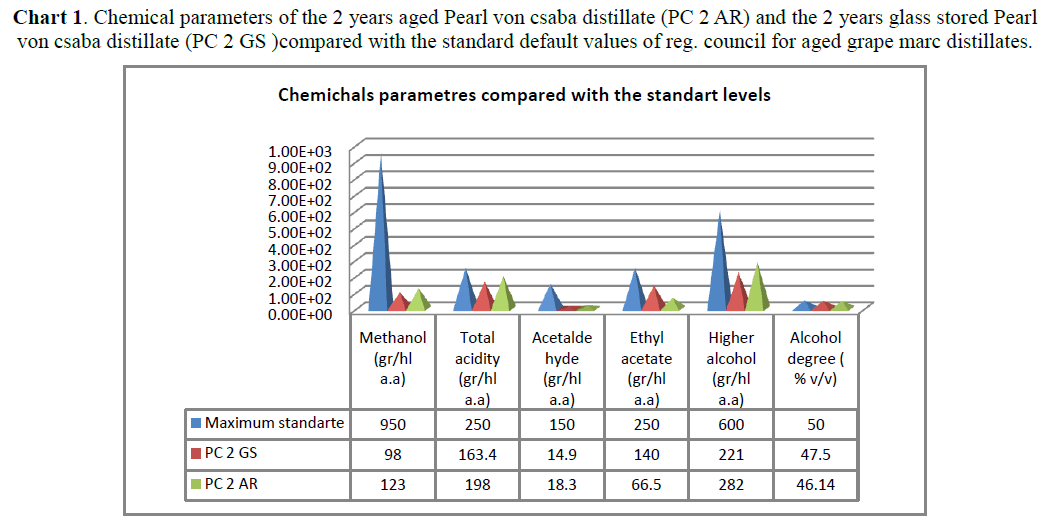 |
| As seen from the results given in chart1 the chemical parameters of the 2 years aged Pearl von csaba distillate (PC 2 AR) and the chemical parameters of the 2 years glass stored Pearl von csaba distillate (PC 2 GS) shows that all the parameters are within standarte default values of reg. council for aged grape distillates. This indicates the best quality of the distillate aged for 2 years in Q.robur |
| Chart 2. The content of the alcoholic degree and aldehyde in Pearl of csaba distillate after 2 years in glass storage and Q. robur ageing |
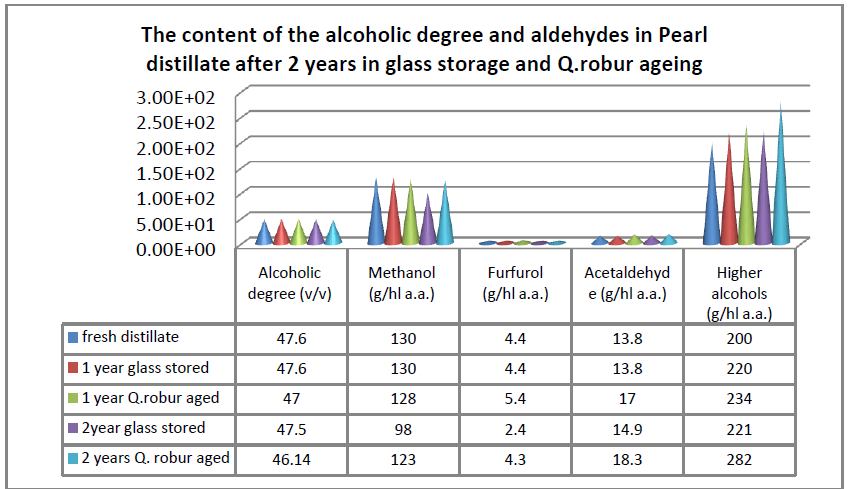 |
| The alcoholic degree of the samples under study was within the margins established by the corresponding Regulation Council (37.5–50% v/v). Acetaldehyde is a volatile compound formed during spontaneous or microbial mediated oxidation during the alcoholic fermentation of raw material. Its concentration in the final distillate is also influenced by the distillation system, the wood and the aging time (Parazzi et al.) [7]. The acetaldehyde concentration increased in lower levels during aging time it owes to the distillation system of the raw material and when the wood species used was Q. robur. The level of acetaldehyde in the aged Pearl von csaba (PC 2 AG) samples ranged between 13.8 to 18.3 g /hl a.a. and in stored Pearl von csaba (PC 2 GS) samples ranged between 13.8 to 14.9 g /hl a.a. this big change in PC 2 AG is due to the oak ageing. Total acidity values in the samples stored in glass is 163.4 g/hl a.a, in the samples aged in oak Q.robur the level of total acidity is 198 g/hl a.a. This parameter decreases significantly during the wood aging process, resulting from oxidation reactions of ethanol and from wood extraction [8]. The methanol content in alcoholic beverages is very important because of its toxicity (maximum legal limit 1000 g/ hl a.a. or 100% vol. ethanol) [9]; This compound is naturally present in distilled grape marc spirits as a consequence of the enzymatic degradation of pectins [10.11]. Methanol content in the analysed samples decrease from 130 gr/ hl a.a of fresh distillate to 123 g/ hl a.a. in the 2 years aged distillate and 98 g/ hl a.a in the 2 years glass stored distillate, this can be attributed to the low pectin content of the raw material employed in the elaboration of the alcoholic distillate, the great change of methanol is detected in glass stored distillate. Methanol did not increase in concentration during the aging process (Parazzi et al.) [7]. Ethyl acetate is the most abundant acetate in the distillates derived from the secondary metabolism of the yeast during the alcoholic fermentation of grape pomace. |
| However, it is the product of acetic acid esterification and thus its concentration increases during the aging process (Onishi, M.J., Guymon, J.F., and Crowlell, A ) [12]. A high content of ethyl acetate in the distillate, above its perception threshold of 180 g/ hl a.a., has a negative impact on sensorial characteristics and is perceived as having a solvent character (Silva, M.L., and Malcata, F.J.) [13]. In the samples analysed, the content of this component is 140 g/ hl a.a in the 2 years glass stored distillate and 66.5 g/ hl a.a. the 2 years aged distillate, contributing fruity and floral notes to the aroma of the distillate. The amount of total higher alcohols in the samples analysed varied from 200 g/hl a.a from fresh distillate to 282 g/hl a.a of 2 years aged distillate and 221 g/hl a.a in the glass stored distillate. The concentration of amino acids, the yeast strain, the fermentation conditions (pH, temperature, time) and the distillation process are all important factors in terms of the concentration of higher alcohols in the final distillate. Higher alcohols comprise the group that is quantitatively more important in the distillates. These volatile compounds are positively involved in the sensory quality of the distillate, if they are not present in high concentrations. The content of higher alcohols in the cognac after aging have an increasement as a result of the phenomenon of concentration by ethanol evaporation (Canas, S et al.) [14]. Theincreasement of the higher alcohols during aging was primarily due to isoamyl alcohol (Parazzi et al.) [7]. Somecompoundsvery important to thequality ofalcoholicdistillateswhich havea direct influence ontheiraromaticprofilearealsoterpenolet, aldehydesandesters. As seenin chart 2, Furfurol as one of the representatives of the aldehydes that comes as a result of overheating the mass of fermented must grape, is present in the fresh distillate 4.4 gr/hl a.a and in the aged distillate after 2 years in Q. robur it increase in 5.4 gr/hl a.a at the first year in the second year of ageing it goes to 4.3 gr/hl a.a but in glass stored it have a direct decrease in 2.4 gr/hl a.a. |
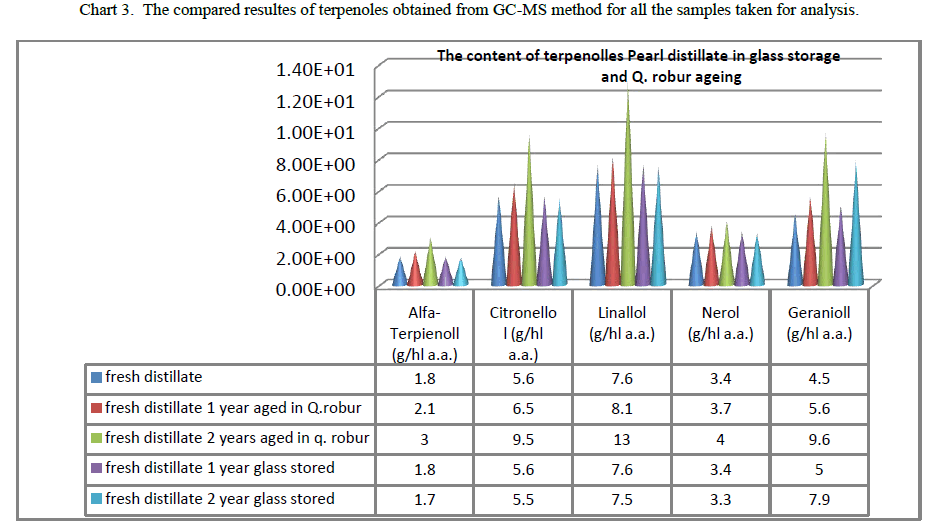 |
| Terpenoles such as linallol, geraniol, citronellol have a huge increasement after 2 years of ageing time in Quercius robur oak. So linallol goes from 7.6 gr/hl a.a of the fresh distillate in 13 gr/hl after 2 years of ageing time. Geraniol goes from 4.5 gr/hl a.a of the fresh distillatein 9.6 gr/hl after 2 years of ageing time. Citronellol goes from 5.6 gr/hl a.a of the fresh distillatein 9.5 gr/hl after 2 years of ageing time. Nerol goes from 3.4 gr/hl a.a of the fresh distillatein 4 gr/hl after 2 years of ageing time. Also as showed in the chart 3 we have some significant changes in the glass stored distillate for 2 years so: Geraniol goes from 4.5 gr/hl a.a of the fresh distillatein 7.9 gr/hl after 2 years of ageing time. But the other analised terpenoles does not change in significant means. These components are the main responsive for the flower aroma of the distillate. |
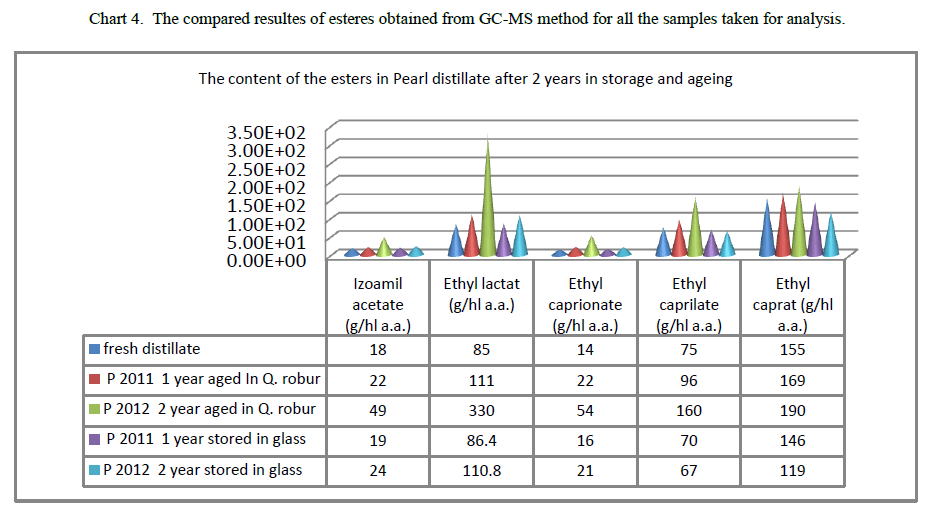 |
| A huge increase of components in the aged distillate is detetcted for: Ethyl caprionate it goes from 14 gr/hl a.a of the fresh distillate in 54 gr/hl a.a after 2 years of ageing in Q.robur. Izoamil acetate it goes from 18 gr/hl a.a of the fresh distillate to 49 gr/hl a.a, Ethyl lactat it goes 85 gr/hl a.a to 330gr/hl a.a, Ethyl caprilate it goes from 75 gr/hl a.a to 160 gr/hl a.a, Ethyl caprat goes from 155 gr/hl a.a to 190 gr/hl a.a but a significant decreasement is detected for ethyl caprat it goes from 155 gr/hl of the fresh distillate to 119 gr/hl a.a for the glass stored distillate after 2 years. Ethyl lactat goes from 85 gr/hl a.a to 110.8 gr/hl a.a after 2 years in glass stored. |
SENSORY ANALYSES |
| The results reveal that the samples of Pearl von csaba (PC 2AR) aged in Quercus robur during 2 years have the best sensory profile and had obtained a greater intensity in all of the qualifying parameters in comparison with the Pearl von csaba (PC 2 GS) stored in glass for the same time. |
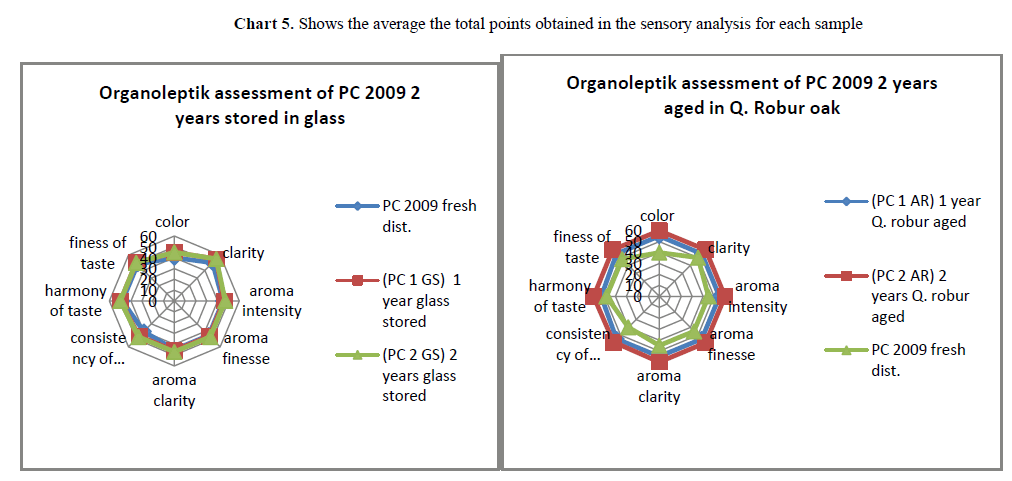 |
CONCLUSIONS |
| Referred to the preceding results emerged from methodology used for the determination of variability of physicochemical characteristics of aromatic compounds of the distillates analyzed, we conclude that the most variability of the compounds is showed at the alcoholic distillate Pearl von csabaPC 2009 aged for two years in Querciousrobur oak than on distillate stored in glass for 2 years. Using the organoleptic technique we detect flower fragrance that is attributable to the grape variety and to the changes of the aromatic compounds under the effect of the ageing process. During the glass storing we don’t see significant change of the main components that influence the aromatic fraction of the distillate. The most variability of the compounds is distinguished in the increasement in content of aldehydes, esters, higher alcohols and terpenoleve, also during the ageing process it resultes a decreaesement of methanol contempt. We notice that in ageing time the Ethyl caprat content increase but in glass storing it decrease in content, furfurol contempt decrease in both cases, acetaldehyde increase after 2 years of ageing time. Ethyl lactate have an increasemnt during storage time and a great increasement in the ageing time, linallol and citronellol increase during ageing time but geraniol increase in both cases. All these changes are related to the the quality of the alcoholic distillate taken in this study. The ageing time results that have a positively impact on the quality of the distillate. |
References |
|